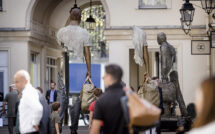
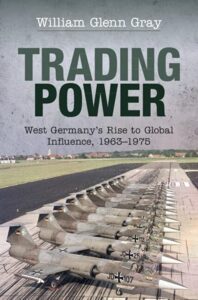
Trading Power: West Germany’s Rise to Global Influence, 1963-1975
By William Glenn Gray
Publisher: Cambridge University Press
Recommended by Nick Ostrum
Following the Russian invasion of Ukraine last year, Germany has stepped forward as a major regional power. Its military advancement—attested in the delivery of items ranging from underwhelming gasmasks early in the war to Leopard II tanks recently provided to Ukraine—is once again becoming a topic of international discussion. Although William Glenn Gray could not have foreseen these recent developments over the more than a decade he has dedicated to researching and writing Trading Power: West Germany’s Rise to Global Influence, 1963-1975, his examination of West Germany’s path from relative international seclusion to economic and geopolitical (though non-militaristic) prominence could not have emerged at a more apropos time. In a sense, this book analyzes the reasons that Germany is such a relevant power today and does it through a deep dive into a decade of German foreign economic policy.
The book starts with the waning days of Adenauer’s Atlanticism in the early 1960s and concludes with the “new multilateralism” of 1974/5, wherein the Federal Republic bore the fruits—favorable trade balances, a strong currency, and international influence—and weathered the shocks—the collapse of the Bretton Woods system, the oil crisis, the devaluing of the dollar, and two economic recessions—that accompanied its new global standing. Indeed, as Gray notes, this was a period of “creative experimentation in German foreign relations,” wherein administrations of various political stripes learned how to abandon military hard power (something denied the country after WWII) and how to exercise their economic and industrial clout to actively shape the global political system. Trading Power stands out in part because of the effective way Gray addresses the globality of Germany’s activities. He studies Germany’s relations with the Soviet east and the American-led west, as well as the tensions within that western bloc, namely those between France and the United States. He also analyzes West Germany’s changing strategies of engagement with the Global South, using the Arab-Israeli conflict and, maybe most notably, Latin American countries such as Brazil as his entry points. This is a formidable book and one that promises to make an impact.
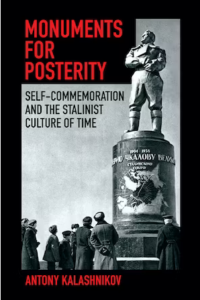 Monuments for Posterity Self-Commemoration and the Stalinist Culture of Time
Monuments for Posterity Self-Commemoration and the Stalinist Culture of Time
By Antony Kalashnikov
Publisher: Cornell University Press
Recommended by Oksana Ermolaeva
Today’s Russian society constitutes a relic of that of the Soviet era; therefore, the cultural and ideological mechanisms by which the Communist state imposed its power over people in the past remain relevant for historical research. As Nikolai Ssorin-Chaikov, a Russian scholar, put it, “The Soviet state’s true power lay not in its presumed centralizing tendencies nor in its repressive actions, but rather in its ability to gradually and slowly penetrate even the places (and spaces) in which it was perceived not to exist.” Antony’s Kalashnikov book, Monuments for Posterity Self-Commemoration and the Stalinist Culture of Time, is devoted to one of the most powerful ideological tools in this process and a very important part of the Soviet cultural imposition upon society: architecture. This greatly interdisciplinary book focuses on the role of Stalinist architecture (mainly based on an analysis of the prominent Soviet architectural projects in Moscow) in the regime’s social engineering project. This project was an important tool to harness and minimize the effects of the Soviet people’s exacerbated feelings of uncertainty and insecurity during an “unabating whirlwind of change during the regime’s modernization projects.” The author explores how anomie, disorientation, and social alienation, which were widespread in Soviet society during the time of “High Stalinism” and beyond, were to be counteracted by assurances of constancy, stability, and mighty collective identity based on a rising national imaginary emanating from the “monuments to posterity.”
Together, cultural, social, anthropological, and aesthetic approaches allow us to explore new ways of thinking about Stalinist temporality and collective immortalization projects as well as about national imagination under authoritarian regimes. In Russia, Stalin-era architectural projects not only “still stand prominently, having weathered iconoclastic campaigns,” but they have acquired a new power to make social, cultural, and ideological impacts precisely because they have preserved their association with Stalinism. Defying reinterpretation, these constructions “continue to support contemporary nationalist, imperialist, and statist commemorative discourses in Russia.” The book paves the way for future explorations of “monuments to posterity” that might open new and until now carefully concealed pages of the history of these monuments. What was the role of the Gulag’s prisoners in erecting these monuments within a grand social and cultural engineering project? How were these monuments received by different categories of people in Soviet society? How did these projects influence the process of acculturation of new cultural and social norms during the time of Soviet urbanization? For people, living near “monuments to posterity,” contributed to the creation of new collective elite imaginaries and fantasies, and these monuments were not only an instrument of “collective amnesia” but also an everlasting, albeit elusive, representation of the “Soviet dream” for millions of provincials flooding into Moscow.
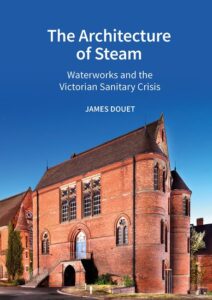 The Architecture of Steam: Waterworks and the Victorian Sanitary Crisis
The Architecture of Steam: Waterworks and the Victorian Sanitary Crisis
By James Douet
Publisher: Liverpool University Press and Historic England Publishing
Recommended by Hélène B. Ducros
In The Architecture of Steam: Waterworks and the Victorian Sanitary Crisis, James Douet takes readers on a tour of exceptional buildings that bring together mechanical engineering inventiveness, architectural design, the history of industrialization and urbanization, and water heritage. Douet not only offers a guide to a wide selection of buildings erected to house pumping stations in Victorian England, but also explains the motivations of architects, engineers, and designers for creating these special places deliberately with the public in mind. Beyond revealing the intricate ways in which these installations inscribed themselves in infrastructural systems of watercourses, reservoirs, and basins, the author shows how they also served as pedagogical institutions to promote civic engagement.
Through a dual thematic and chronological approach, Douet lays out how steam pump buildings contributed answers to social crises as part of wider sanitation policies. As ground-breaking as the technology inside them stood, these buildings, whose primary function was to encase pumping stations, were also designed to dazzle and impress. Architects, in their quest for a unique style for these special places, were stimulated by different trends influential at the time, for example borrowing from Gothic Revival or drawing inspiration from the canons of the Italian Renaissance. Moreover, as the history of these buildings tells us about water management and water governance, the book also addresses water access rights in industrializing England. By lifting the veil of anonymity off these extraordinary buildings, the book displays them as testimonies of industrial water development and serves as a model for the retracing of the history of other industrial landscapes, giving new life and meaning to abandoned, recycled, reused, or reinvented structures once symbolic of modernity and progress.
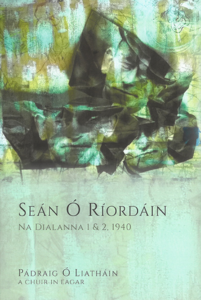
Seán Ó Ríordáin: Na Dialanna 1 & 2,2 1940
By Pádraig Ó Liatháin
Publisher: Cló Iar-Chonnacht
Recommended by Sorcha de Brún
One of the most exciting publications in Irish language academic scholarship of 2023 is Seán Ó Ríordáin: Na Dialanna, 1 & 2: 1940 (Seán Ó Ríordáin: The Diaries, 1 & 2, 1940). Edited by Irish language scholar Pádraig Ó Liatháin of Dublin City University, Ireland and published by Cló Iar-Chonnacht based in Indreabhán, Galway, Ireland, this beautifully edited and designed book comprises the first volume of diary entries from 1940 of Irish language poet Seán Ó Ríordáin. Born in 1916, the year of the Irish “Rising” and a year of revolution and uprising which ultimately overthrew British rule in Ireland and secured Irish independence, Ó Ríordáin was a prolific Irish language poet from Baile Bhúirne (Ballyvourney) in the Cork Gaeltacht, or Irish speaking area.
This first published volume of Ó Ríordáin’s diaries offers an entirely new perspective for academics, scholars, and students on Ó Ríordáin as the major Irish language writer that he was. In reading the entries in Ó Liatháin’s superbly edited tome, this reader cannot help but be struck by the manner in which the quotidian nature of the diary genre clearly afforded Ó Ríordáin a vehicle with which to explore emotional ambiguity through the medium of prose writing. A complex individual, Ó Ríordáin employs a variety of styles to describe his inner thoughts and the workings of his art. Indeed, the poet sometimes uses lightness of touch, an almost carefree sensibility, to express his young life’s darker moments. This edited collection will function as fascinating reading not only for scholars of Ó Ríordáin’s poetry but also for historians. For example, Ó Ríordáin’s entries on the war raging in Europe show how engaged the young poet was with events of the time. Moreover, while Ó Ríordáin cannot be said to be necessary typical of young Irish men of his day, the diaries shine a light into the life of this young Irish-speaking male poet. As Ó Liatháin himself notes in the online Irish language newspaper of Dublin City University, scáthán, the diaries are not without their sadness, and there is pathos in Ó Ríordáin’s terse entries on his tuberculosis, from which he died in 1977. Overall, such a wealth of autobiographical material provides context and depth for some of Ó Ríordáin’s most challenging poetry, as well as providing fresh forays into his more accessible work.
Of central importance to Seán Ó Ríordáin: Na Dialanna, 1& 2: 1940 is that, in editing these diaries, Ó Liatháin has produced a fascinating book that highlights the diary in the Irish language as genre in its own right and as a vehicle for the formation of the creative writer. While the centrality of diary writing to creativity has a long record in English and American literary scholarship in relation to writers such as Virginia Woolf and Katherine Mansfield, this is the first time that the diary’s importance in Irish, and to Irish, is significantly showcased. The publication of the diaries results from much scholarship, artistry, and imagination. A landmark in Irish language literary studies, Seán Ó Ríordáin: Na Dialanna, 1 & 2, 1940 is the fruit of Ó Liatháin’s editing and emanates from the vision of modern Irish scholar Breandán Ó Buachalla (1936-2010), whose purchase of the Seán Ó Riordáin papers for University College Dublin in 1984 forms part of this story.
Published on May 1st, 2023.

